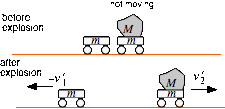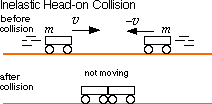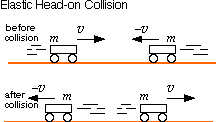

p1’ + p2’ = mv1’ + (m+M)v2’ = 0
(m+M)v2’ = –mv1’
mv2’ +Mv2’ = –mv1’
Mv2’ = –mv1’– mv2’
M = (– mv1’– mv2’)/v2’
M = (– v1’/v2’–1)m
Because v2 and v1 are in opposite directions the ratio – v1’/v2’ is positive. Because cart 2 carries the extra mass, its speed will be slower and the ratio is greater than one.
For example if v1’ is –3 m/s, v2’ is 1 m/s and the cart has a mass of 0.5 kg, then the mass of the object is
M = [–(–3 m/s / 1 m/s) –1] 0.5 kg = 1 kg.
Imagine the reverse of the explosion that we just discussed. Both carts come towards each other in a head-on collision. If both carts have the same masses and speeds then they will both come to rest after they hit the Velcro pads. This collision is completely inelastic: all the kinetic energy disappears. It is hardly necessary to do any mathematical analysis to understand the outcome.

Rear-end Collission
There is a devious trick used by professional physicists that I would like to show you. In the head-on inelastic collision, the result was almost obvious. What about a rear-end collision where a moving cart hits a nonmoving cart and sticks? What is the velocity of the two carts after they hit? The trick is to imagine that we are travelling along at 1/2 the velocity of the moving cart. From this point of view, the stationary cart is coming towards us at –v/2 and the the cart approaching from behind is moving at +v/2. In other words, changing to this frame of reference subtracts v/2 from every cart’s velocity. The accelerations and forces are the same in both frames of reference so long as they are moving at constant velocity.

The result of the collision is obvious from the moving frame of reference: the carts will be stuck together and not moving. To find out how this looks to an observer on the ground just add v/2 to the velocity. The two carts end by moving at v/2 when viewed from the Earth’s frame of reference.
If changing frames of reference gives you a headache, then one can revert to a more pedestrian way of analysing the collision of the cart moving at velocity v with a stationary cart. The following analysis is more general in that the cars are allowed to have different masses, m1 and m2. At the end we can set the two masses equal and verify that the final result for identical carts is the same as we get by the above reasoning.
Initially the total momentum is
p1 + p2 = m1v + 0
After the collision the total momentum is the same as before,
mv1’ + mv2’ = 0.
In addition the two velocities are equal
v1’ = v2’ = v’.
p1’ +p2’ = (m1 + m2)v’.
Setting the initial and final momenta equal to each other allows predicting the final velocity:
m1v = (m1 + m2) v’
v’ = [m1/ (m1 + m2)] v.
If the two carts have the same mass then
v’ = v/2
Which is just the result that was predicted by jumping into and out of moving frames of reference.
Elastic Collisions: Hit and Bounce
In this case the bumpers have elastic bumpers which give back all the energy they absorb during the collision. The carts used in our lab exercise have magnets which oppose the magnets on the end of the colliding cart. These magnets act as almost perfectly elastic bumpers.
This type of collision can be analysed by assuming that both the total momentum and and the total kinetic energy are the same before and after the collision. An obvious case to analyse is that of two carts in a head-on collision. This time the elastic bumpers give back the energy, they don’t stick. It seems reasonable that after the collision, the two carts will have the same speeds by will be going in the opposite directions.

Elastic Rear-end Collision
One of the carts is not moving before it is hit the other cart is heading toward it at velocity v.
The following picture shows the situation. You are to follow the analysis in the say way that the inelastic rear-end collision was analysed by first moving to a frame-of-reference moving at v/2.

We can now work out mathematically what happens in the earth frame of reference.
There is a mathematical trick which makes the analysis a little easier if we are willing to think in terms of momentum rather that velocity. The kinetic energy of a moving object is defined as (1/2)mv2. This can be expressed in terms of momentum as follows:
KE = (1/2) mv2
KE = (1/2m) m2v2
KE = p2/2m
The total momentum and kinetic energy is conserved from before to after the collision.
Before the collision we have
Total momentum : p1 + 0
Total Kinetic Energy: p12/2m1 + 0
After the collision
Total momentum: p1’ + p2’
Total Kinetic Energy: p1’2/2m1 + p2’2/2m2
Setting momentum before equal to momentum after and KE before equal to KE after gives two separate equations.
p1 = p1’ + p2’
p12/2m1 = p1’ 2/2m1 + p2’ 2/2m2
Transform the first equation by squaring both sides.
Transform the second by multiplying by 2m1.
p12 = p1’ 2 + 2 p1’p2’ + p2’ 2
p12 = p1’ 2 + (m1/m2) p2’ 2
subtract these two equations to give
(m1/m2) p2’2 = 2 p1’p2’ + p2’2
(m1/m2) p2’ = 2 p1’ + p2’
p1’ = (1/2) ( m1/m2–1 )p2’
This shows that when m1=m2, the first mass stops after the collision. This should be confirmed by the pictoral analsys above.
Using
p1 = p1’ + p2’
p1 = (1/2) (m1/m2 – 1) p2’ + p2’
p1 = (1/2)(m1/m2 +1) p2’
solving for p2’
p2’ = 2p1/(m1/m2 +1)
This gives the momentum of the second object as a function of the masses of the balls.
What happens if the second ball is very small compared to the first? Then (m1/m2+1)can be approximated by m1/m2
p2’ = 2p1/(m1/m2)
p2’/m2 = 2p1/m1
(m2 v2’)/m2 = 2 (m1 v1)/m1
v2’ = 2 v1.
The little runt takes off at twice the speed of the big guy.
(This is reasonable. Think of a ball hitting the ground with velocity –v and bouncing. After the bounce it is going +v and he change in velocity is 2v. Another way ot looking at this is that the ball is stationary an the earth comes up and hits it. According to our calculation the change in velocity is 2 v. The change in velocity is the same independent of the frame of reference.)
Solving for p1’
p1’ = p1 – p2’
= p1 – 2p1/(m1/m2) = p1(1– 2 m2/m1)
but if m1 >> m2 then p1’ is about p1, in other words, the original object is hardly affected by hitting the little runt.
